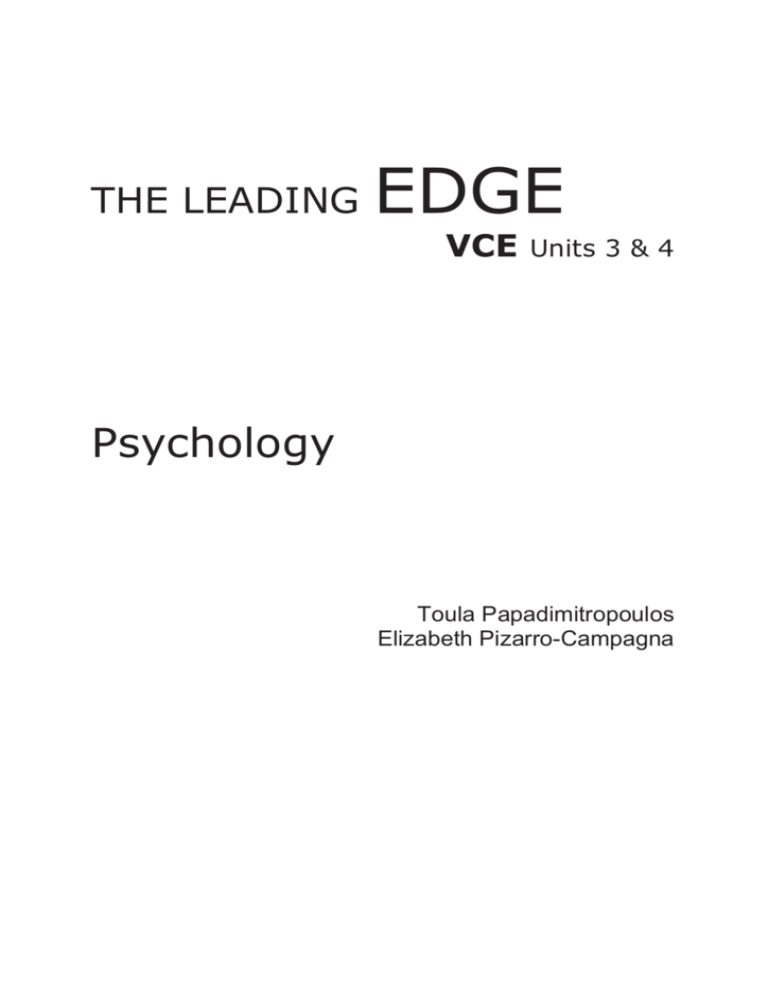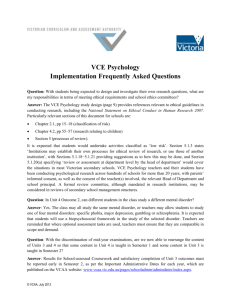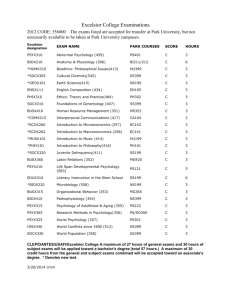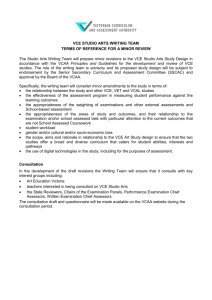Psychology - narrewarrenpsych
advertisement

THE LEADING EDGE VCE Units 3 & 4 Psychology Toula Papadimitropoulos Elizabeth Pizarro-Campagna Contents Preparing for Exams 1 Cram Notes Unit 3 Area of Study 1: Brain and nervous system Area of Study 2: Visual perception Area of Study 3: States of consciousness 5 15 23 Cram Notes Unit 4 Area of Study 1: Memory Area of Study 2: Learning Area of Study 3: Research investigation 32 41 49 Handling Exam Questions 55 Getting the Edge Unit 3 58 Getting the Edge Unit 4 69 Practice Examination 1 Answers 81 101 Practice Examination 2 Answers 105 123 Tear-Outs Multiple-Choice Answer Sheet Daily Study Planner Ready-for-it Checklist 127 129 131 This icon indicates that you can find relevant weblinks at www.hi.com.au/theleadingedge iii The Leading Edge – VCE Psychology Preparing for Exams So you want to do well in your VCE exams. That makes sense: you want to maximise your prospects of getting into the higher education course of your choice or of getting the job you’re after. Although your final result will be based on both school-assessed coursework and external exams, the main purpose of this Exam Success Guide is to prepare you for those exams. If you maintain consistent homework habits throughout the year, you’ll build good foundations for handling the exams. But additional, purposeful study is essential for exam success. Studying for exams involves a concentrated effort to revise and practise the knowledge and skills you have developed throughout the year. Even if you have been slow to start this exam preparation, it’s not too late. START NOW! Some basics Your workplace • • • • • Create a pleasant but functional work area that, if possible, is ‘yours’. Try to find a place that is quiet and free of distraction and has sufficient desk space to spread out your learning materials. Make sure you have good lighting (preferably from behind), good desk height and a comfortable chair (preferably adjustable). Organise your work area so that all essential tools are handy – pens, paper, eraser, highlighters, white-out, ruler, calculator, etc. This will save time, effort and frustration. Organise material for your different subjects and topics using clearly labelled folders, trays, shelves or boxes. After each homework or study session, re-organise and tidy your workplace so that you can get down to work easily next time. Body and mind • • • • Your mind works best when your body is healthy. Eat balanced and regular meals (this includes breakfast!) and avoid too much caffeine. Get plenty of physical activity. You’ll feel more positive and work more effectively. After a study session, take time off to let your mind ‘wind down’ before going to bed. Get enough sleep. You work better when you’re fresh. Balancing act • • Maintain a sensible balance between study and the other things in your life (like going out, playing sport and music, and perhaps a part-time job). During your study time and between the exams, continue some of your creative and physical activities to keep a positive frame of mind. 1 The Leading Edge – VCE Psychology How do I know what to study? Obviously, you have to study all the aspects of the course that are examinable. So it is essential that you understand the structure and content of the course. This can be found in the VCAA Study Design. Your teacher, as your most valuable resource, may provide you with the relevant parts of this. Your teacher may also provide you with relevant parts of the other VCAA documents mentioned below. Alternatively, they are all available at the VCAA website. The VCAA Study Design For each subject, the VCAA provides a booklet called the Study Design. This is your starting point. It outlines the Areas of Study and specifies the Key Knowledge and Key Skills that you must develop for that subject. You cannot be examined on anything not contained in it. Hint: As you study for the exam, refer to the Key Knowledge and Key Skills checklist for each Area of Study in the Cram Notes, and tick them off as you cover them. You should then be prepared for any question. The Assessment (Exam) Criteria The Assessment Criteria are the things the examiners will be looking for in your exam answers, and are the measures by which your exam performance will be marked. You need to be aware of these criteria when answering exam questions so you can respond in a way that clearly satisfies them. For the most up-to-date list of the Assessment Criteria for Psychology, see the VCE Psychology Assessment Handbook. This can be found at the VCAA website. Hint: Have a copy of the Assessment Criteria in front of you when you are answering practice questions. Think about which criteria you would be expected to address in your answers. Past exam papers Looking at these will give you an idea of the sorts of questions that examiners ask and how they ask them. They also show the format of the exam paper. (Check with your teacher about any changes that may have been made to the types of questions asked and to the format of the exam paper.) Hint: Try completing one or more past exam paper(s) in the given time limit. (You can use the exam timer enclosed.) Compare your answers to model ones, where available. There are some model answers in the Getting the Edge chapter of this Exam Success Guide, starting on page 58. Examiners’ reports Every year the examiners write a report on the last exam. Reading these reports is a good way to ‘get inside the examiners’ heads’ and find out what they expected in the answers. The reports also show what were regarded as good answers as well as giving hints for improvement. 2 The Leading Edge – VCE Psychology Hint: Get the Examiners’ Report for the past exams you try and check your practice answers against the examiners’ comments. Examiner’s reports are available from the VCAA website. How do I study? Different study techniques work for different people. However, planning and organising are the keys to success. Among the following suggestions, you should find some that will work for you: • Map out a study timetable. Even if you have to alter it, you will see from the start what you have to get through. Use the study planner provided in this book, or a wall chart or calendar. Make your study timetable realistic by allowing for the other things that are important in your life (family, sport, etc.). • List what study tasks you have to do each day and tick each off as you complete it. This will remind you of what you have achieved. • Allocate adequate time to each subject – not just to your favourite. • Plan realistically. Setting unachievable goals will only make you feel bad. • Make study sessions about 50 minutes long and allow for a 5- to 10-minute break between sessions. • Prioritise tasks. Do the most important or pressing tasks first. Resist the temptation to go over what you are already comfortable with in order to avoid those areas/topics you find difficult. • Break large tasks into smaller, manageable bits. Ticking each task off as you complete it will add to your sense of achievement. • Set a realistic aim for each session such as summarising a topic or completing a sample answer. When you’ve achieved your goal, reward yourself by doing something you enjoy during your break. • Match all that you study to the Areas of Study indicated in the Study Design. • Jot down any points you don’t understand and ask your teacher to explain. • Change activities if you are losing concentration. Although you may want to concentrate on the next exam, you will have to cover all subjects eventually and a change of focus can give you a fresh mind-set. • Do some stretching exercises when taking a break from sitting at the desk. • Use active study techniques. Passively reading through your notes, though a good start, is not the best way to prepare for exams. Active study techniques help you to control panic, maintain focus and retain what you’ve learned. 3 The Leading Edge – VCE Psychology Cram Notes Unit 3 These Cram Notes summarise key concepts and content for Psychology Unit 3, following the requirements of each Area of Study in the VCAA Study Design. Use them to help you raise your knowledge and understanding of what will be tested in the external exam. Area of Study 2: Visual perception Outcome 2 On completion of this unit the student should be able to explain the nature of processes involved in visual perception. Study Design checklist Use this checklist to check that you are familiar with the Key Knowledge and Key Skills for this outcome by placing a tick in the appropriate space. Key Knowledge Characteristics of the visual perceptual system: the interactive nature of processes of the retina and the brain in reception, transduction, transmission, selection, organisation and interpretation of stimulus information. Response to light and the concept of thresholds, absolute and differential (just noticeable difference). Organisation in visual perception as evidenced in art, signs and symbols: Gestalt principles (figure–ground, closure, similarity, proximity), depth perception (binocular – retinal disparity, convergence, monocular – accommodation, pictorial cues, linear perspective, interposition, texture gradients, relative size and height in the visual field), visual constancies (size, shape, brightness, orientation). The effect of context and past experience on perception through perceptual set. Distortions of visual perception by illusions, including Muller-Lyer and Ames room. Research methods in visual perception, including use of participant selection, random and stratified sampling, participant allocation; control and experimental groups. Ethical principles in the conduct of psychological research. Key Skills Explain the distinction between absolute and differential thresholds. Use evidence to explain the principles of visual perception. Explain visual illusions as distortions of visual perception. Explain the strengths and limitations of random and stratified sampling. Design a research investigation to demonstrate the use of participant selection and allocation, and control and experimental groups. Source: Psychology Victorian Certificate of Education Study Design, Victorian Curriculum and Assessment Authority, 2004, pp 21–22 15 The Leading Edge – VCE Psychology Getting the Edge Unit 3 Multiple-choice questions Hints on answering multiple-choice questions When answering multiple-choice questions it is important to pay attention to all of the information provided within the stem of the question. Read the question and consider each choice carefully. Remember there are three options in the answers to distract you and direct you away from the correct answer. Be sure to read the information provided carefully and cancel out any choices that are clearly not the answer. Make sure you NEVER leave out a multiple-choice question. Even if you do not know the answer, you still have a 25% chance of choosing the correct answer. Question 1 During a skiing accident, Zack bruised and grazed much of his body including both of his hands, which are now bandaged. He wanted to eat a nectarine, but because he could not pick it up using his hands he asked his friend to feed it to him. Because he does not like to eat very ripe, soft fruit he asked his friend to first allow him to touch it with his unbruised forearm. It seemed firm enough, until the fruit touched his lips and he noticed it was too soft. Touching the fruit with his lips was more effective than touching it with his forearm because A the lips have a smaller representation in the somatosensory cortex than the forearm. B the lips have a greater representation in the somatosensory cortex than the forearm. C the lips have a smaller representation in the primary motor cortex than the forearm. D the lips have a greater representation in the primary motor cortex than the forearm. Read the question carefully to work out the aspects of the Study Design examiners are testing. For example, ‘touch’ indicates the question could be about the somatosensory cortex. C and D can be disqualified because the primary motor cortex is not involved in processing touch. B is the correct answer. Question 2 Which of the following is a function of the somatic nervous system? A It initiates functioning of the body’s internal muscles, organs and glands. B It initiates the fight–flight response. C It is part of the peripheral nervous system. D It initiates movement of the body’s skeletal muscles. Read the question and every option carefully. Note key words such as ‘function’. Do not immediately choose the answer that may sound right, such as C. Although the information in C is true of the somatic nervous system, it is not a function. D is the correct answer. 58 The Leading Edge – VCE Psychology SECTION A – Multiple-choice questions Instructions for Section A There are 22 questions for Area of Study 1 and 23 questions for Area of Study 2. Answer all questions in pencil on the answer sheet provided for multiple-choice questions. Choose the response that is correct or that best answer the question. A correct answer scores 1, an incorrect answer scores 0. Marks will not be deducted for incorrect answers. No marks will be given if more than one answer is completed for any questions. AREA OF STUDY 1 – Memory Question 1 The memory process called retrieval refers to A B C D the storage of new information in memory. the conversion of new information into a form to be stored in memory. the recovery of stored information from memory for use. the mechanism that makes unpleasant memories inaccessible to long-term memory. Question 2 The memory process involved in answering short-answer questions on an exam requires A B C D recall. relearning. recognition. re-read. Question 3 Which of the following is the most sensitive measure of memory retention? A B C D retrieval relearning recognition recall Question 4 The information that our senses first receive is stored initially in A B C D procedural memory. short-term memory. long-term memory. sensory memory. 106 SECTION B – Short answer questions Question 1 Encoding is the initial step in the memory process, where information received by the senses is converted into a format the brain can understand (1 mark), while storage refers to the retention of information and memories over time. (1 mark) Question 2 Any one of the following: (1 mark for any one) • Recognition method uses cues to retrieve memories. • Recognition method involves matching currently perceived information with that stored in memory. • More sensitive than the test of recall. Question 3 i. 0.3–4 seconds (1 mark) ii. 20 seconds (1 mark) iii. up to a lifetime (1 mark) Question 4 Features of iconic memory (any one of): (1 mark for either) • temporary store for information that is received from the visual system • sensory information is stored in a raw, unprocessed form Features of echoic memory (any one of): (1 mark for any one) • temporary store for information that is received from the auditory system • believed to be necessary for the comprehension of many sounds, especially speech • sensory information is stored in a raw, unprocessed form Question 5 i. motivated forgetting (1 mark) ii. Retroactive interference occurs when new information interferes with the retrieval of old information. For example, you study for a psychology exam and the next day study for a biology exam. The following day you sit your psychology exam and find you can only remember the course for biology. The new biology information has interfered with the retrieval of the old psychology information. (2 marks) Question 6 state-dependent cue (1 mark) Any one of the following: (1 mark for either) • There is evidence that a learner’s emotional or physiological state is also remembered along with information they are trying to learn. Therefore their state at the time of learning could be used as cues to retrieve information. • Information tends to be better remembered when learners are in a similar mood at retrieval as they were when initially learning the information. Question 7 Reflex action is a simple behaviour that is involuntary (1 mark). For example, you salivate if food is put into your mouth. (1 mark) 124







